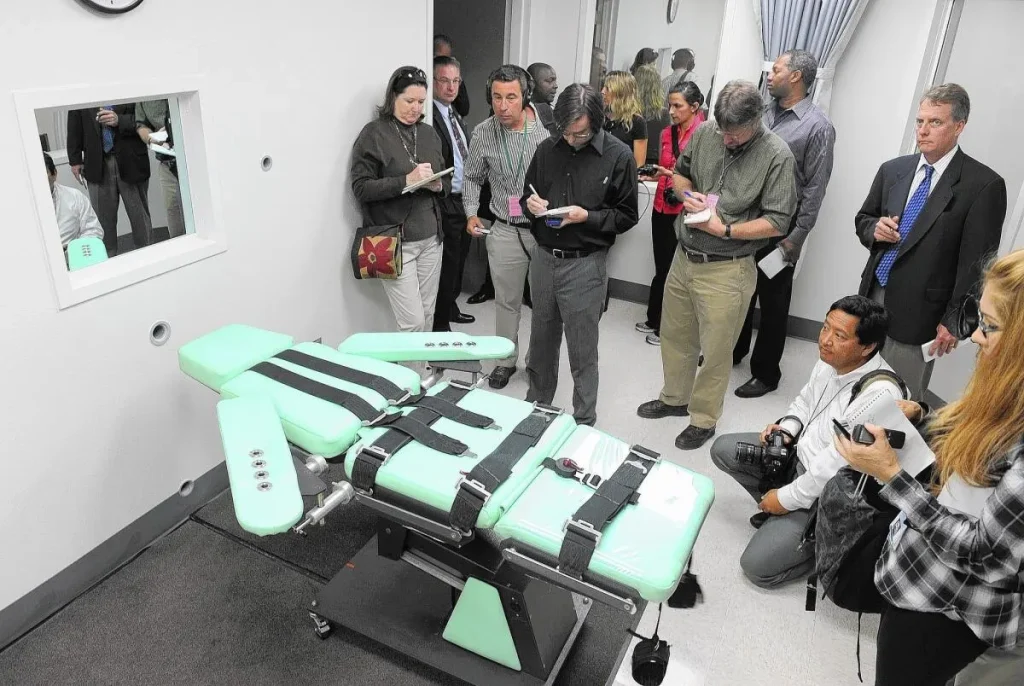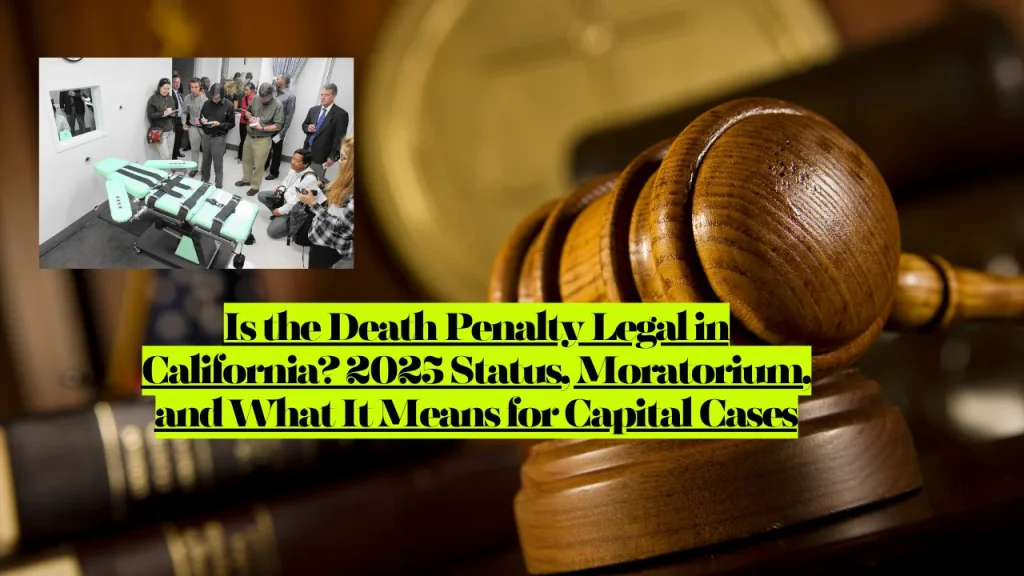Is the Death Penalty Legal in California? 2025 Status, Moratorium, and What It Means for Capital Cases
Yes, the death penalty is legal in California under state law, but Governor Gavin Newsom’s 2019 executive order instituted a moratorium halting all executions while he remains in office. As of April 2025, 589 people remain on death row—down nearly 10% from 2024—though no one has been executed since 2006.
California voters have repeatedly rejected abolition efforts, most recently in 2016 when they defeated Proposition 62 (which would have eliminated capital punishment) and passed Proposition 66 (which speeds up the appeals process). The contradiction between legal status and enforcement creates a unique situation: death sentences continue, but executions don’t.
Current Legal Status: Active Law, Frozen Enforcement
California’s death penalty remains codified in state law under various sections of the California Penal Code, but Governor Newsom’s March 13, 2019 executive order instituted a moratorium in the form of a reprieve for all people sentenced to death. The order also called for repealing California’s lethal injection protocol and immediately closing the execution chamber at San Quentin State Prison.
In his announcement, Newsom declared: “The intentional killing of another person is wrong and as Governor, I will not oversee the execution of any individual. Our death penalty system has been, by all measures, a failure. It has discriminated against defendants who are mentally ill, black and brown, or can’t afford expensive legal representation”.
The moratorium is executive, not legislative—it doesn’t abolish the death penalty or commute existing sentences. Courts can still impose death sentences, and the legal framework remains intact.
What California Penal Code Says About Capital Punishment
Pursuant to Penal Code 3600, every male sentenced to death is to be delivered to the warden of the California state prison designated by the California Department of Corrections and Rehabilitation for the execution of the death penalty. The individual must be kept in a California prison until execution of the judgment.
Proposition 66, a ballot measure passed by California voters in 2016, allows prison officials to transfer condemned incarcerated people to any state prison that provides the necessary level of security. Before 2016, state law mandated that male prisoners on condemned status be housed at San Quentin State Prison and women at Central California Women’s Facility.
The last execution in California occurred in 2006, when Clarence Ray Allen was put to death by lethal injection. Since then, 13 people have been executed in California since the death penalty was reinstated in 1977, though 181 other people have died on death row from other causes (32 of them from suicide) as of June 6, 2025.

California Death Row Population Drops Below 600
The high number of resentencings and deaths in 2024 resulted in the largest single-year change in California’s death row population since the NAACP began tracking in 1991. The NAACP’s Winter 2025 Death Row USA report estimates that 591 people are currently on death row in California, down from 641 last year.
As of April 10, 2025, CDCR reports 589 people under a condemned sentence across its prisons. Of these, approximately 18 are women serving in general population at the Central California Women’s Facility, and approximately 571 are men relocated from San Quentin.
The dramatic decline stems from multiple factors: natural deaths, suicides, resentencings by progressive district attorneys, and fewer juries willing to impose death sentences. Based on DRUSA records, the last time California’s death row population was below 600 people was in 2000.
San Quentin Death Row Dismantled
On January 31, 2022, Governor Newsom announced that the current death row at San Quentin State Prison will be dismantled within two years and that the inmates housed at said facility will be transferred to other maximum security state prisons. By February 5, 2025, all but 9 of the male inmates had been moved out of San Quentin, with the last group expected to transfer after completing medical and psychiatric programs.
San Quentin’s execution chamber is now permanently closed. The transferred inmates are required to work paid prison jobs, though 70% of their wages are withheld and designated as restitution to victims’ families. Death row at San Quentin is being repurposed “into something innovative and anchored in rehabilitation,” according to corrections spokeswoman Vicky Waters.
Voters Keep Rejecting Abolition
California voters have consistently rejected efforts to eliminate capital punishment:
Proposition 34 (2012): Would have replaced the death penalty with life imprisonment without parole. Defeated 52% to 48%.
Proposition 62 (2016): Another abolition attempt that would have replaced capital punishment with life without parole and resentenced all current death row inmates. Rejected by voters in the November 2016 election, with 53.1% voting against it.
Proposition 66 (2016): Passed alongside Proposition 62’s defeat. Approved by voters with 51.1% voting to speed up executions by changing procedures governing California state court challenges to capital punishment, designating superior court for initial petitions, and limiting successive petitions.
A UC Berkeley Institute of Governmental Studies poll in April 2021 found that 44% of California’s registered voters supported a proposed 2022 constitutional amendment to abolish the death penalty, with 35% opposed and 21% undecided. 48% supported Governor Newsom’s death penalty moratorium executive order, with 35% opposed.
The poll revealed sharp partisan divides: Democrats opposed the death penalty 63%-37% while Republicans supported it 68%-32%.

Historical Timeline: California’s Death Penalty Evolution
1851: Death penalty established when California became a state.
1972: California Supreme Court ruled capital punishment unconstitutional in People v. Anderson, declaring it “cruel and unusual punishment.”
1972: Voters passed Proposition 17, reinstating the death penalty in the state constitution months after Anderson.
1977: State Legislature overrode Governor Jerry Brown’s veto and reinstated the death penalty, allowing for capital punishment in first-degree murder cases.
1978: Capital punishment fully restored under a statute approved by People v. Frierson in 1979.
1992: State’s first post-Anderson execution carried out.
2006: Last execution in California (Clarence Ray Allen).
2012: Voters rejected Proposition 34, which would have abolished the death penalty.
2016: Voters rejected Proposition 62 (abolition) and passed Proposition 66 (expedited appeals).
2019: Governor Newsom issued executive order halting all executions.
2022: San Quentin death row dismantling began.
2025: Death row population drops below 600 for first time since 2000.
Constitutional Challenge Pending Before State Supreme Court
The California Supreme Court is considering a landmark petition filed in April 2024 by the ACLU, the ACLU of Northern California, the Legal Defense Fund, Wilmer Hale, and the Office of the State Public Defender challenging the state’s death penalty statute as racially discriminatory and unconstitutional under the Equal Protection guarantees of the California Constitution.
The petition demonstrates that racial disparities in California’s implementation of the death penalty are persistent, pervasive, and well documented. A forthcoming report from the Habeas Corpus Resource Center reveals that 19 of the 23 statewide death sentences (83%) since Governor Newsom’s moratorium have been imposed on defendants of color.
In June 2025, more than 200 Californians and representatives of civil rights organizations gathered at the state Capitol to urge Governor Newsom to commute all death sentences. Speakers called California’s death penalty statute unconstitutional and noted persistent evidence of racial bias, historic ties to lynching, ineffective protection of innocent lives, and high costs.
New Death Sentences Continue Despite Moratorium
There were three new death sentences in 2024, all in suburban Southern California counties, compared to four in 2023. Only six of the state’s 58 counties (10.3%) have sentenced anyone to death in the last five years.
The counties that continue to seek death sentences represent isolated geographic pockets, primarily in Southern California. San Bernardino County imposed one death sentence in 2024. No other counties imposed new death sentences, based on tracking by legal observers and sentencing logs.
Capital cases are more expensive at every stage: pre-trial, trial, and post-conviction. Each case involves two separate phases—one to determine guilt, the other to decide the sentence—and decades of appeals. All of it is paid for by taxpayers.
How California Compares to Other States
In the United States, capital punishment is a legal penalty in 27 states (of which two, Oregon and Wyoming, have no inmates sentenced to death), throughout the country at the federal level, and in American Samoa. Capital punishment has been abolished in the other 23 states and in the federal capital, Washington, D.C.
California is unique: it has the nation’s largest death row population yet hasn’t executed anyone in nearly two decades. Other states with executive moratoria include Pennsylvania (Governor Josh Shapiro continues the hold begun by Governor Wolf) and Oregon (Governor Tina Kotek continues the hold).
On February 13, 2025, Ohio Governor Mike DeWine said he does not anticipate any more executions happening during his governorship, effectively joining states with executive holds on capital punishment.
What the Moratorium Means for Criminal Cases
The moratorium doesn’t prevent prosecutors from seeking the death penalty or courts from imposing death sentences. It only prevents executions from being carried out.
In December 2020, Los Angeles County—California’s most populous county—announced prosecutors would no longer seek the death penalty for eligible crimes. This policy shift by newly elected District Attorney George Gascón significantly reduced death penalty prosecutions statewide.
Defendants sentenced to death since the moratorium still receive automatic appeals and can challenge their convictions through habeas corpus petitions, but they face life imprisonment rather than execution as the practical outcome.
The Cost of California’s Death Penalty
Business leader Matthew Stepka, a member of Business Leaders Against the Death Penalty, called California’s death penalty system a failure of both justice and fiscal responsibility in a July 2025 op-ed. The coalition includes over 500 global business leaders calling on Governor Newsom to commute all death sentences to life without parole.
A substantial number of death sentences are overturned; between 1973 and 2013, approximately one-third were vacated or reversed. Multiple state audits and reports, including by the Legislative Analyst’s Office and the California Commission on the Fair Administration, document the extraordinary costs of California’s capital punishment system.
Frequently Asked Questions
Is the death penalty currently legal in California?
Yes, the death penalty remains legal under California law and codified in the California Penal Code. However, Governor Gavin Newsom’s March 2019 executive order instituted a moratorium halting all executions while he remains governor. The moratorium doesn’t abolish the death penalty or prevent courts from imposing death sentences—it only stops executions from being carried out.
When was the last execution in California?
The last execution in California occurred on January 17, 2006, when Clarence Ray Allen was put to death by lethal injection at San Quentin State Prison. No executions have taken place for nearly 20 years due to court disputes over lethal injection procedures and Governor Newsom’s 2019 moratorium.
Can someone still be sentenced to death in California?
Yes, courts can still impose death sentences in California despite the moratorium. Three new death sentences were imposed in 2024, all in suburban Southern California counties. However, many counties—including Los Angeles County since December 2020—no longer seek the death penalty for eligible crimes.
How many people are on death row in California?
As of April 2025, 589 people are on California’s death row, down from 641 in 2024. This represents nearly a 10% decrease in a single year and marks the first time the death row population has fallen below 600 since 2000. The decline results from natural deaths, suicides, resentencings, and fewer new death sentences.
Why hasn’t California abolished the death penalty?
California voters have repeatedly rejected ballot measures to abolish capital punishment, most recently in 2016 when they defeated Proposition 62 (53.1% against) and passed Proposition 66 (51.1% for) to speed up the appeals process. A 2021 poll showed 44% support for abolition, 35% opposition, and 21% undecided, reflecting divided public opinion on the issue.
What happened to San Quentin’s death row?
Governor Newsom announced in January 2022 that San Quentin’s death row would be dismantled within two years. By February 2025, all but 9 of the male death row inmates had been transferred to other maximum security state prisons. The execution chamber is permanently closed, and the death row area is being repurposed for rehabilitation programs.
Could a future governor resume executions?
Yes. The moratorium is an executive order, not a law or constitutional amendment. A future governor could rescind the executive order and resume executions if the legal framework for lethal injection procedures is resolved. However, the dismantling of San Quentin’s execution infrastructure creates practical barriers to resuming executions quickly.
Related Resources
Explore related legal topics:
- What Impact Did the Criminal Laws in Hammurabi’s Code Have – Historical perspective on criminal law evolution
- Which Level of Government Writes the Majority of Criminal Laws – Understanding state vs. federal criminal legislation
- Is Verbal Assault Actually a Crime – Criminal law definitions and enforcement
Disclaimer: This information is for educational purposes only and does not constitute legal advice. Consult an attorney specializing in criminal law for specific legal guidance regarding capital cases, death penalty appeals, or criminal defense matters.
About the Author

Sarah Klein, JD, is a licensed attorney and legal content strategist with over 12 years of experience across civil, criminal, family, and regulatory law. At All About Lawyer, she covers a wide range of legal topics — from high-profile lawsuits and courtroom stories to state traffic laws and everyday legal questions — all with a focus on accuracy, clarity, and public understanding.
Her writing blends real legal insight with plain-English explanations, helping readers stay informed and legally aware.
Read more about Sarah
